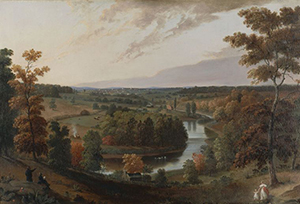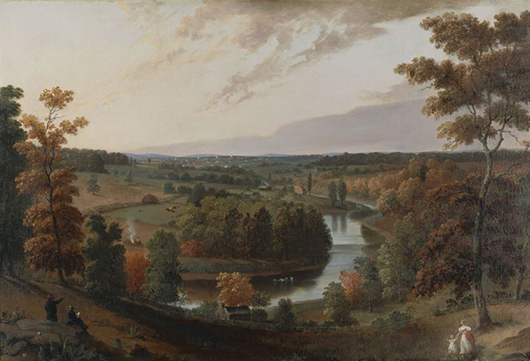
It was a reminder of home for the artist’s eldest daughter, who had recently moved to Philadelphia.
Last week, East Petersburg resident Jay Parrish stood at the head of a ravine in a nook of woods just off the fairway of the fourth hole on the course of the Meadia Heights Golf Club.
The mother in her plump day dress was no longer there holding one arm of her gesturing daughter. The stone house that once stood on the creek bank is now a flattened green. Two men are no longer admiring the view from the jagged limestone rocks, which now have been filled in by soil and sport two sand traps off to their side.
Trees block a lot of the Lancaster skyline now. But the luminescent white steeple of Trinity Lutheran Church is just visible through a sycamore tree, just as it was in the autumn scene that Eichholtz painted.
“This is it,” says Parrish, former Pennsylvania state geologist, with an unmistakable air of satisfaction.
This is where the artist, known throughout much of the early republic for his portraits, stood with his easel 181 years ago, putting the finishing touches on his sweeping painting. He had waited until a killing frost had dropped the leaves and Eichholtz could get distant objects right.
How did Parrish know where the painter stood?
It wasn’t easy and Parrish had to play detective, piecing together clues taken from the modern marvels of radar topography and digital visualization, along with gumshoe sleuth methods of hoofing it to knolls and looking for himself.
Solving the artistic mystery began 11 years ago when Thomas R. Ryan, president and CEO of LancasterHistory.org, was curating an exhibit of Eichholtz’s collected works at three locations in Lancaster.
Parrish, who was friends with Ryan’s wife, saw the 1833 painting and heard Ryan mention that no one knew where the artist had set up.
Parrish, who was working for the state Bureau of Topographic and Geologic Survey, ventured that he thought he could figure it out.
First, Parrish and Ryan deduced from the church spires, Furnace Hills in the background and bend in Conestoga Creek (now river) that the spot was somewhere south of the city.
Then, using radar imagery of topography, the two looked at 3D views on a computer and selected three possible sites.
Parrish drew lines directly north from each of the candidate sites to one of the church steeples in the painting. Digital visualization, confirmed by on-site visits, ruled out two of the sites because the views did not match that of the painting.
That led Parrish and Ryan to a knoll and ravine just south of a peninsula that now holds part of Greenwood Cemetery. It may once have been known as Kreider’s Hill.
“It was an extraordinary moment,” says Ryan, who did his doctorate thesis on Eichholtz.
The river peninsula is still mostly farmed, just as it was in Eichholtz’s time.
They also found the distinguished rock outcropping in the painting, though the rocks have been much filled in over time. “Back in the 1800s, everything was clear-cut for firewood and there was a lot of erosion,” Parrish explains.
Parrish found the little stone cottage in the center foreground of the painting on the 1864 Atlas of Lancaster County. At the time, it was known as the Elias Herr homestead.
“It all matched up beautifully,” recalled Parrish, who is now a Geographic Information Systems and geospatial data consultant. “Lancaster painters were pretty accurate about what they saw and you could rely on them for the view.”
Parrish does say the artist took some liberties with the Furnace Hills in the distance but notes that Eichholtz did not have the aid of binoculars at the time.
He believes the scene now isn’t quite as grand as Eichholtz made it seem on canvas. But he finds it ironic that after the passage of 181 years it’s the growth of trees, rather than development, that have altered what the artist saw.
“I felt pretty good that I had found the exact spot where he was standing when he did it,” Parrish says.
So good, in fact, that three years later, he made a presentation to the Geological Society of America, using the Eichholtz connection as an example of the practical uses of digital visualization.
___
Online:
___
Information from: LNP, http://lancasteronline.com
Copyright 2014 Associated Press. All rights reserved. This material may not be published, broadcast, rewritten, or redistributed.
AP-WF-11-18-14 1819GMT
ADDITIONAL IMAGE OF NOTE



